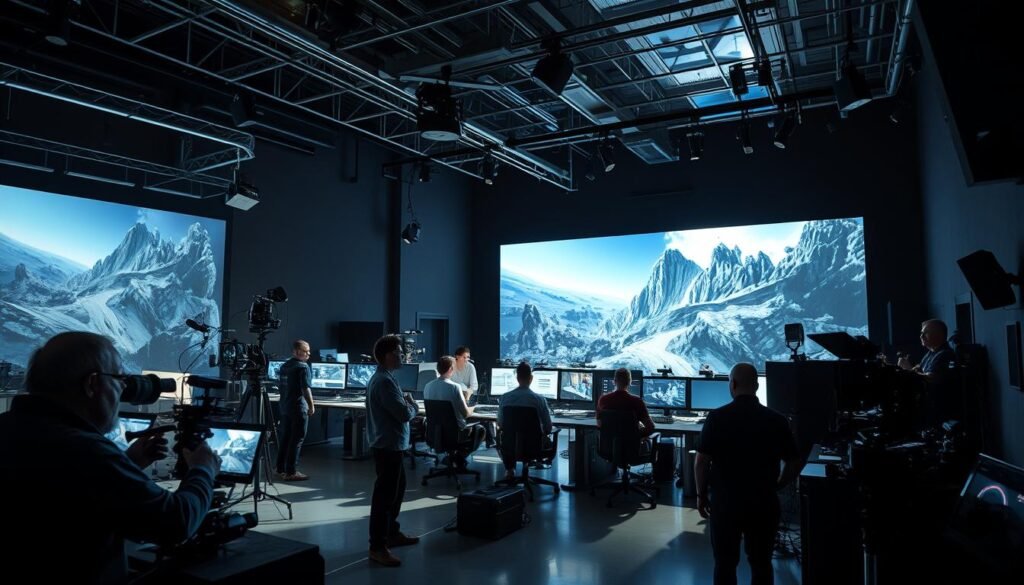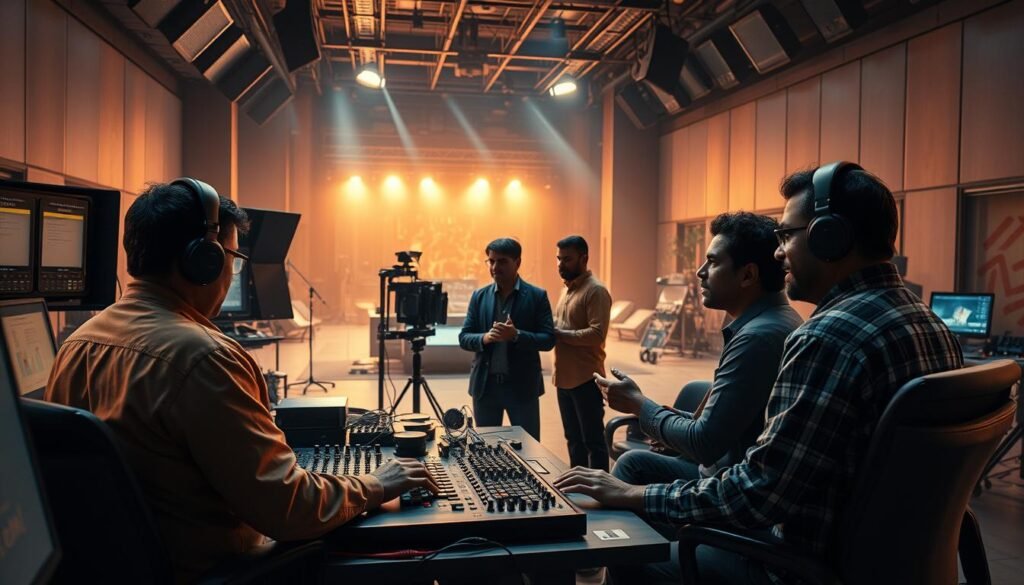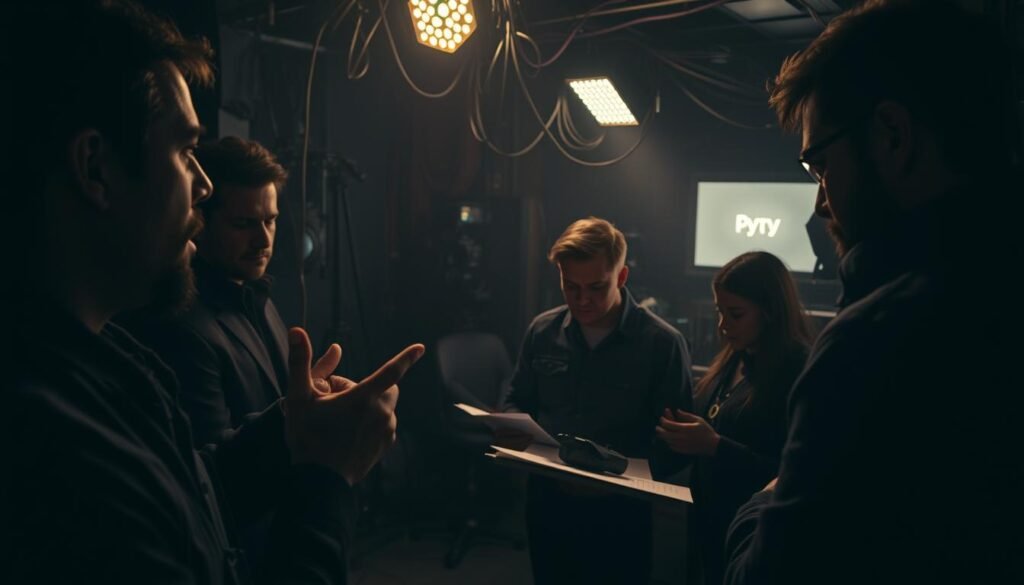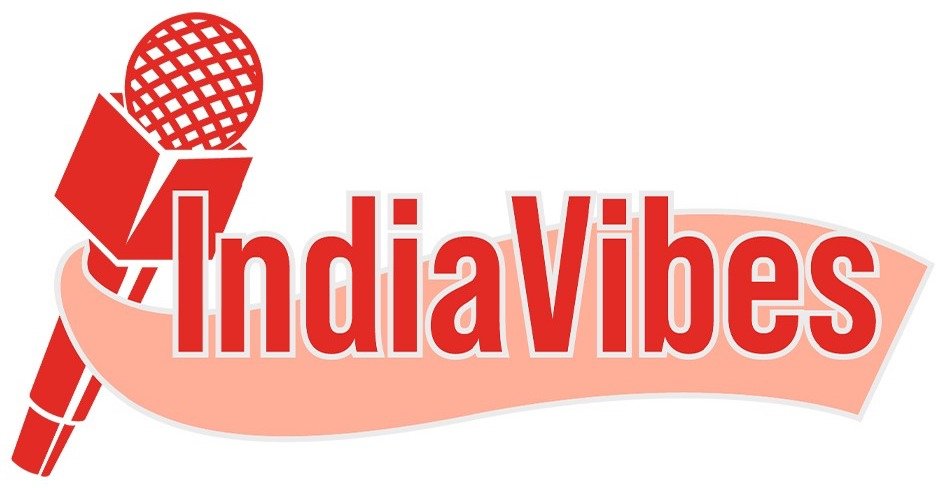When Malayalam film Thudarum revealed its poster last month, fans marveled at the lifelike reunion of screen legends. Few realized they were witnessing history – the first major Indian production using neural networks to resurrect iconic performers. This breakthrough mirrors global trends where machine learning reshapes everything from scriptwriting to special effects.
Visual storytelling now operates at lightspeed. Tools that de-aged Robert De Niro in The Irishman and revived Carrie Fisher’s Princess Leia now empower Mumbai studios. We’re seeing South Indian filmmakers prototype hyper-realistic crowd scenes through algorithms, while northern production houses test AI-dubbed regional versions.
This technological leap democratizes high-end production. Regional creators can now visualize epic battle sequences rivaling Hollywood budgets. Marathi indie directors experiment with predictive editing software that analyzes audience reactions frame-by-frame.
The revolution extends beyond screens. Marketing teams generate localized trailers using emotion-recognition systems. Dubbing artists collaborate with voice-cloning tools that preserve vocal nuances across languages. Every innovation serves a greater purpose – amplifying our diverse stories through smarter tools.
As boundaries between code and creativity blur, we stand at a crossroads. Will machines dilute our artistic soul? Or become the ultimate collaborator? The answer unfolds in Chennai soundstages and Hyderabad render farms where tradition meets tomorrow’s toolkit.
Technological Transformations in Storytelling and Production Quality

Modern film crews wield digital brushes that paint worlds beyond physical limitations. Last year’s Malayalam sci-fi experiment Gaganachari proved this shift – its team crafted interstellar vistas using neural networks trained on NASA imagery. Such breakthroughs redefine what’s possible when creative vision meets computational power.
Innovative Tools Enhancing Visual Effects and CGI
Smart compositing software now merges live footage with CGI elements in real time. One Mumbai studio recently recreated historic Mumbai streetscapes through photogrammetry algorithms – a process that previously took months now completes in weeks. These tools empower creators to prototype entire sequences before shooting begins, saving crucial resources.
Streamlining Production Through Intelligent Systems
Automated cinematography rigs capture complex action scenes with surgical precision. During a recent Telugu jungle thriller, AI-stabilized drones filmed chase sequences through dense foliage – shots once deemed too risky. Predictive editing platforms analyze raw footage to suggest optimal cuts, letting filmmakers iterate faster during post-production.
The ripple effects reach beyond major studios. Regional creators access cloud-based rendering farms through subscription models. A Marathi historical drama recently generated 10,000 digital crowd characters for a pivotal battle sequence – a feat unimaginable five years ago. As technology erases old boundaries, every storyteller gains tools to match their ambition.
AI and VFX in Indian Cinema: The Future of Filmmaking Has Arrived

India’s cinematic landscape speaks in 20 tongues – a richness that once challenged creators. Traditional dubbing methods often diluted emotional depth across languages. Now, neural networks analyze vocal patterns to clone iconic voices while adapting regional dialects. When Amitabh Bachchan’s baritone needed Tamil adaptation for Vettaiyan, the system preserved his signature rhythm yet matched lip movements frame-perfectly.
Revolutionizing Post-Production Workflows
Editors now wield smart tools that auto-sync dialogue with facial expressions. Predictive algorithms scan raw footage to suggest optimal cuts, freeing creatives to focus on storytelling rhythm. One Bengali thriller team reduced editing time by 40% while enhancing narrative tension through machine-assisted pacing.
| Process | Traditional Method | AI-Enhanced Approach |
|---|---|---|
| Dubbing | 6-week recording sessions | 3-day voice cloning |
| Subtitling | Literal translations | Culture-aware adaptations |
| Storyboarding | Manual sketches | 3D scene simulations |
Pre-Visualizing Stories Through Machine Intelligence
Directors prototype battle sequences through generative tools before shooting begins. A recent Kannada epic used depth-sensing cameras to map sets, then algorithmically populated them with 8,000 digital warriors. These systems don’t replace artists – they amplify what human imagination can achieve.
The true magic lies in balance. As one Mumbai sound engineer shared: “Our tools now understand pauses between words matter as much as the words themselves.” This technical empathy helps regional films resonate globally without losing their authentic voice.
Challenges and Ethical Considerations in AI-Driven Filmmaking

Global creators face pressing questions as intelligent tools reshape storytelling. Recent Hollywood strikes revealed deep concerns when 160,000 artists demanded protection from digital replication. These tensions echo worldwide – how do we harness machine efficiency without eroding human artistry?
Balancing Creativity with Data-Driven Production
Data analytics now influence casting choices and plot decisions. While algorithms predict audience preferences, over-reliance risks homogenizing content. A Tamil director shared: “Our tools suggest ‘safe’ endings – but great films demand courageous choices.”
| Challenge | Traditional Approach | Modern Solution |
|---|---|---|
| Actor Consent | Lifetime image rights | Blockchain permissions |
| Script Development | Writer rooms | Human-AI co-creation |
| Cultural Adaptation | Local experts | Context-aware algorithms |
Maintaining Authenticity in Storytelling Amid Automation
Machines struggle with regional idioms and emotional subtext. When recreating a Bengali folk tale, an AI-generated character missed the tale’s spiritual essence. Artists intervened, blending digital precision with cultural wisdom.
The path forward demands collaboration. Mumbai’s new Creator-Tech Alliance brings filmmakers and engineers together monthly. Their goal? Develop tools that amplify rather than replace the human voice. As one participant noted: “Our stories deserve more than perfect pixels – they need beating hearts.”
Charting the Next Chapter for Indian Cinema
Our screens are becoming portals to uncharted worlds – where virtual stages replace physical sets and algorithms collaborate with artists. Emerging technologies like augmented environments and smart rendering are rewriting rules for visual storytelling. These innovations let creators build entire universes at lower cost, while preserving cultural authenticity.
Virtual production blends live-action shoots with real-time digital backdrops, empowering directors to experiment freely. Smaller studios now access cloud-based tools once reserved for big budgets. A recent Marathi fantasy film crafted its mythological realm through this hybrid approach – proof that ambition no longer depends on resources alone.
Yet growth demands balance. While automation handles repetitive tasks, human artistry remains irreplaceable. The industry invests in training programs to bridge technical gaps, ensuring storytellers wield these technologies effectively. As one Kochi-based animator shared: “Our tools should amplify imagination, not replace it.”
The path ahead shines bright. With cutting-edge processes and collaborative spirit, Indian cinema positions itself as both innovator and cultural ambassador. Every frame now carries potential to dazzle local audiences while captivating global viewers – a new golden age forged through silicon and soul.




